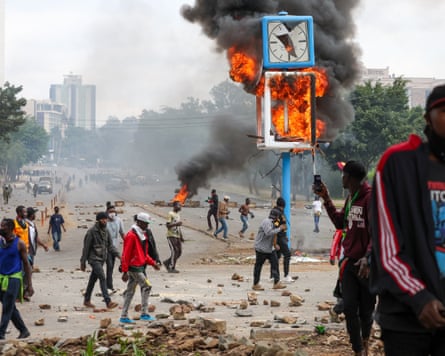Introduction
At least eight people have been killed and more than 400 injured as massive anti-government protests rocked Kenya protests on June 25, 2025. Protesters took to the streets across Nairobi and other cities, demanding President William Ruto step down. The government’s controversial economic policies and political crackdown have triggered widespread discontent, especially among the youth.

This marks the one-year anniversary of similar deadly demonstrations against the 2024 Finance Bill that sparked violent confrontations. Many Kenyans believe the government has failed to address systemic issues, such as inequality, corruption, and declining public services.
Police Confront Peaceful Protesters
The protests began peacefully, with demonstrators chanting “Ruto must go” and waving tree branches to symbolize nonviolence. However, police responded with tear gas, rubber bullets, and water cannons. Barricades and razor wire were used to block access to State House and Parliament. Protesters attempted to breach these perimeters, escalating tensions further.
According to a Washington Post report, security forces were given broad powers to suppress the protests, despite a High Court ruling lifting the government’s ban on live coverage of the demonstrations. Video footage shows dense plumes of tear gas blanketing parts of Nairobi as people fled in panic.
Casualties and Growing Anger
The Kenya Medical Association, Law Society of Kenya protests, and the Police Reforms Working Group released a joint statement confirming at least eight deaths and more than 400 injuries. Of those, 83 people require specialized treatment, and eight have gunshot wounds. Three injured are police officers.

Meanwhile, human rights organization Amnesty Kenya estimates that the death toll could be as high as 16. The BBC reports some protesters were carrying signs bearing the names of victims killed in last year’s unrest Kenya protests.
Voices from the Ground
“I joined the protest to fight for the future of my kids,” said Amina Mude, a mother of two who traveled from Mombasa. “I feel like the country is heading in the wrong direction—especially in education. It’s time the leadership listens.”
Her sentiment resonates with many young Kenyans who are turning to activism. The Gen Z-led movement in Kenya has become a powerful force calling for political transparency, accountability, and inclusive governance.
Government Reaction
President William Ruto, who was not in Nairobi during the peak of the protests, addressed the nation from Kilifi County. “Protests should not destroy peace in Kenya,” he said. “We don’t have another country. Let us keep this one safe.”
)
Yet critics say the administration has done little to prevent police violence and instead has fueled mistrust by limiting press freedom and ignoring court rulings. The president’s absence from State House at a time when protesters were marching towards it was viewed as symbolic of growing disconnect between the ruling elite and the public.
Political and Legal Fallout
The political fallout from these protests could be significant. Lawyers and human rights defenders are calling for an independent inquiry into the killings and police conduct. Meanwhile, calls for President Ruto’s resignation are growing louder, as the government faces mounting pressure both domestically and internationally.
International watchdogs, including The Guardian, have begun spotlighting the crisis in Kenya, calling for calm, dialogue, and a return to democratic norms.
Conclusion

The June 25 protests mark a critical turning point for Kenya. As youth-led movements gain momentum and international scrutiny grows, the government will be forced to address its deep-rooted challenges or risk further unrest. The fight for democracy and press freedom in Kenya is far from over.
Stay updated with more global coverage at The Morning News Informer.









